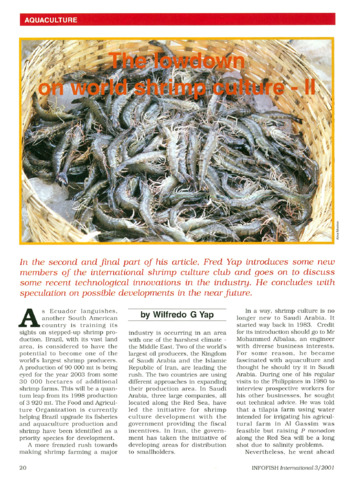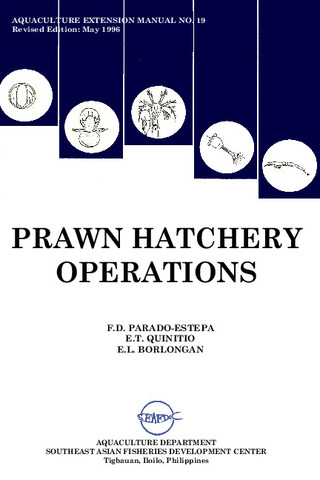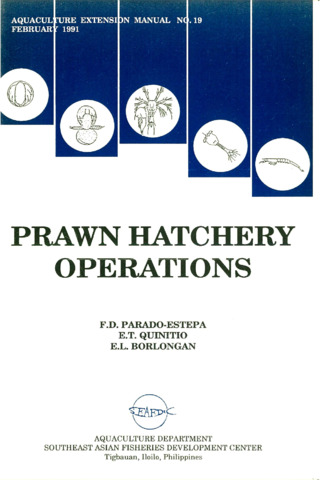Perlihatkan publikasi sederhana
Antibacterial metabolites in the microbial and phytoplankton flora of the "green water" culture of shrimp (Penaeus monodon): Part III. Biocontrol of luminous Vibrio in the grow-out culture of shrimp (Penaeus monodon)
| dc.contributor.author | Lio-Po, Gilda D. | |
| dc.contributor.author | Franco, Annie | |
| dc.contributor.editor | Nagasawa, Kazuya | |
| dc.date.accessioned | 2020-07-22T02:18:12Z | |
| dc.date.available | 2020-07-22T02:18:12Z | |
| dc.date.issued | 2005-03 | |
| dc.identifier.citation | Lio-Po, G. D., & Villa-Franco, A. U. (2005). Antibacterial metabolites in the microbial and phytoplankton flora of the "green water" culture of shrimp (Penaeus monodon): Part III. Biocontrol of luminous Vibrio in the grow-out culture of shrimp (Penaeus monodon). In K. Nagasawa (Ed.), Recent Advances in Diagnosis and Prevention of Fish and Shrimp Diseases in Southeast Asia (pp. 182–195). Tigbauan, Iloilo, Philippines: Aquaculture Department, Southeast Asian Fisheries Development Center. | en |
| dc.identifier.isbn | 9718511732 | |
| dc.identifier.uri | http://hdl.handle.net/10862/5926 | |
| dc.description.abstract | The development of an “indigenous probiotic” for the grow-out culture of black tiger shrimp (Penaeus monodon) was pursued in this study. Five of nine bacterial isolates with demonstrated anti-luminous Vibrio metabolites showed non-virulence towards exposed P. monodon postlarvae (PLs) compared to the Vibrio harveyi control and the uninoculated negative control after 7 days exposure. Growth of these selected test bacteria at different salinities were optimum with total bacterial counts (TBC) of 107 to 109 cfu/mL at salinities of 15, 20 and 30 ppt. Bacterial population reduction was observed in most bacterial isolates including V. harveyi at 5 ppt. Co-cultivation of the bacterial isolates in pairs with luminous Vibrio demonstrated that most combinations resulted in the loss of their anti-luminous Vibrio properties. Only the co-cultivation of isolates 1213 and 1725 demonstrated consistent maximum inhibition of luminous Vibrio for 24 to 48 hr. Subsequent multiple combinations of four bacterial isolates 508 + 1213 + 1725 + 1896 or 508 + 1213 + 1637 + 1725 were shown to exert maximum anti-luminous Vibrio inhibition in 24 to 48 hr. The application of the “indigenous probiotic” and or Chaetoceros calcitrans in pond waters to shrimp pond soil showed that either or both treatments effectively reduced the luminous Vibrio population in 1-5 days post-exposure causing one to two logs reduction of luminous Vibrio in 5-7 days post-exposure. Penaeus monodon PLs treated with the “indigenous probiotic” before stocking in tanks yielded higher mean survival rates of 62-92% in comparison with the 50% survival rate of untreated control shrimps. The biomass was also higher in treatments where PLs were exposed to the “indigenous probiotic” upon packing at the hatchery source (treatments B, C and D) with weight ranges of 87.04-101.18 g while shrimps in the control tank without treatment (treatment A) or of PLs exposed to the “indigenous probiotic” after transport or upon stocking in tanks (treatment E) had average weights of 79.82 g and 79.43 g, respectively. Overall, both survival rates and biomass were highest in cultured P. monodon exposed to the “indigenous probiotic during transport and with bi-monthly addition (treatment D), yielding a mean weight of 101.18 g and survival rate of 92%. Viability assays of the selected bacteria after inoculation in sterile seawater medium indicated that these remained viable and stable for >45 days. The “indigenous probiotic” when cultivated in varying concentrations of nutrient broth, fish meal and rice bran suspensions, showed a more stable growth in 0.1% nutrient broth and 0.5% fish meal media yielding bacterial populations of 107-108 cfu/mL. Growth depression was observed with rice bran solutions attaining bacterial population levels of only 101-105 cfu/mL. By and large, the development of an “indigenous probiotic” in this study is a significant step towards the biocontrol of luminous vibriosis in the grow-out culture of black tiger shrimp. | en |
| dc.language.iso | en | en |
| dc.publisher | Aquaculture Department, Southeast Asian Fisheries Development Center | en |
| dc.subject | Vibrio | en |
| dc.subject | Penaeus monodon | en |
| dc.subject | pathogenicity | en |
| dc.subject | isolation | en |
| dc.title | Antibacterial metabolites in the microbial and phytoplankton flora of the "green water" culture of shrimp (Penaeus monodon): Part III. Biocontrol of luminous Vibrio in the grow-out culture of shrimp (Penaeus monodon) | en |
| dc.title.alternative | Part III. Biocontrol of luminous Vibrio in the grow-out culture of shrimp (Penaeus monodon) | en |
| dc.type | Book chapter | en |
| dc.citation.spage | 182 | en |
| dc.citation.epage | 195 | en |
| dc.citation.bookTitle | Recent Advances in Diagnosis and Prevention of Fish and Shrimp Diseases in Southeast Asia | en |
| dc.subject.asfa | biological control | en |
| dc.subject.asfa | shrimp culture | en |
| dc.subject.asfa | probiotics | en |
| dc.subject.asfa | pathogens | en |
| dc.subject.asfa | salinity | en |
| dc.subject.asfa | Bacteria | en |
| dc.subject.asfa | Algae | en |
| dc.subject.scientificName | Penaeus monodon | en |
| dc.subject.scientificName | Chaetoceros calcitrans | en |
Files in this item
Publikasi ini ada di koleksi berikut
-
Recent Advances in Diagnosis and Prevention of Fish and Shrimp Diseases in Southeast Asia [43]
Terminal Report of the Regional Fish Disease Project on “Development of Fish Disease Inspection Methodologies for Artificially-Bred Seeds” Funded by the Government of Japan Trust Fund from 2000 to 2004


 AQD Access only
AQD Access only



